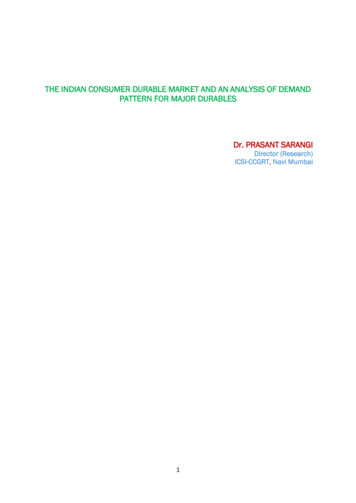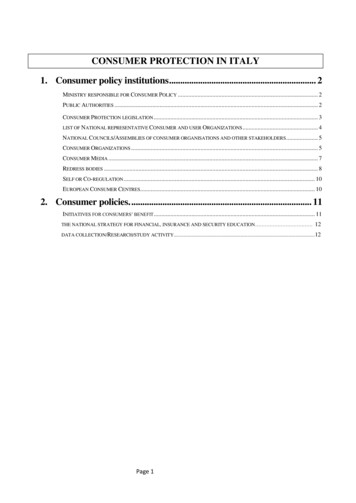
Transcription
THE INDIAN CONSUMER DURABLE MARKET AND AN ANALYSIS OF DEMANDPATTERN FOR MAJOR DURABLESDr. PRASANT SARANGIDirector (Research)ICSI-CCGRT, Navi Mumbai1
THE INDIAN CONSUMER DURABLE MARKET AND AN ANALYSIS OF DEMAND PATTERNFOR MAJOR DURABLES1.INTRODUCTION:With the continuous inflow of disposable income and the advancement of technology,the need for the varied consumer durable goods are increasing. This in turn is leading toa strong competition among the different consumer durable brands available in thenation. The rural and urban market of consumer durables has been growing at a rate ofaround 15 % on an average.When a new durable is introduced initially a small fraction of the population will purchaseit and gradually its potential buyers will increase. This will continue till all the potentialbuyers own it. This lead to the diffusion of durables. This happens because of theoutcome of the interaction of a number of quantitative and qualitative factors. Somedurables become outdated which are no longer in demand due to availability of bettersubstitutes.Consumer durables refer to those consumer goods that do not quickly wear out andyields utility over a long period of time. Some of the popular and common examples ofthese kinds of items are electronic goods, kitchen appliances, home furnishings andleisure equipment etc. Consumer durables can be broadly categorized into thefollowing 3 heads: White Goods: White goods mainly include air conditioners, refrigerators,washing machines, audio equipment and speakers. Brown Goods: This kind of consumer durables mostly include kitchenappliances like chimneys, electric fans, grinders, iron, microwave ovens, mixersand varied other cooking ranges. Consumer Electronics: Some of the mostly used consumer electronic goods areDVD players, MP3 players, mobile telephones, telephones, VCD players etcEmpirical studies on durables are poorly represented whereas non-durables have beenintensively studied. The recent literature shows that such studies are scanty and a fewstudies done so far have estimated the Logit or Probit model to compute threshold2
probability, range of predicted probabilities and threshold level of income for theacquisition of durables.2.REVIEW OF RELATED LITERATURESCramer (1962) using the Dutch data fitted the logistic growth curve to know the patternof demand for refrigerator, washing machine, water heaters, vacuum cleaner etc. andobserved that the demand for these item are restricted to highest income groups. Unitprice of the durables shows no systematic variation in the demand for these durables.Pattanaik has estimated both logit and probit models incorporating some importantdeterminants of demand for major and minor durables. He has explored the effect ofsome of the important determinants of demand for durables; estimated the thresholdlevel of income and probabilities for acquiring durables and diffusion of these durablesamong different occupation group of households in Orissa. Sarangi et al. has estimatedthe diffusion of major and minor durables by using both qualitative and quantitativedeterminants in a business town of Odisha state. The result proved various factorsaffecting on the demand of durables. There is a growing body of literature on time-seriesand cross-section studies on durables in marketing research but we rarely find studieson demand for household durables.3.OBJECTIVE OF THE STUDYThe basic objective of the present study is to explore the effect of various determinantsin the purchase of major and minor durables.(i). To study the Indian market of consumer durable industry(ii). To explore the effect of some important quantitative determinants of demand formajor durables in the study area4.AN OVERVIEW OF INDIAN CONSUMER DURABLE MARKET:The consumer durable industry consists of durable goods and appliances for domesticuse such as televisions, refrigerators, air conditioners and washing machines. Theconsumer durables market is estimated to be US 15 billion as on May 2017 and isexpected to reach US 20.6 billion by 2020. Urban markets account for the major share3
(65 per cent) of total revenues in the consumer durables sector in India. There is a lot ofscope for growth from rural markets with consumption expected to grow in these areasas penetration of brands increases. Consumer electronics exports from India reachedUS 186.7 million during April-September 2017. Also demand for durables likerefrigerators as well as consumer electronic goods are likely to witness growing demandin the coming years in the rural markets as the government plans to invest significantly inrural electrification.Growing awareness, easier access, and changing lifestyles have been the key growthdrivers for the consumer market. The Government of India's policies and regulatoryframeworks such as relaxation of license rules and approval of 51 per cent foreign directinvestment (FDI) in multi-brand and 100 per cent in single-brand retail are some of themajor growth drivers for the consumer market.India is likely to emerge as the world’s largest middle class consumer market with anaggregated consumer spend of nearly US 13 trillion by 2030, as per a report by Deloittetitled 'India matters: Winning in growth markets'.Fuelled by rising incomes and growing affordability, the consumer durables market isexpected to expand at a compound annual growth rate (CAGR) of 14.8 per cent to US 12.5 billion in FY 2015 from US 7.3 billion in FY 2012. Urban markets account for themajor share (65 per cent) of total revenues in the Indian consumer durables sector. Inrural markets, durables, such as refrigerators, and consumer electronic goods are likelyto witness growing demand in the coming years. From US 2.1 billion in FY 2010, therural market is expected to grow at a CAGR of 25 per cent to touch US 6.4 billion in FY2015.Source: JP Morgan, TechNavio, Spark Capital estimates and EY analysis4
The Market of white goods and televisions has growing since the year 2009. The chart-1derived below shows the market growth over various years for the mentioned four goodsand a projection of growth by the year 2020. In an analysis it is observed that the CAGRbetween the years 2009 to 2013 was at 13.7% which increased to CAGR of 17% fromthe year 2013 to projected year 2020.The total market which was INR 403 billion for the four white goods including TV hasreached to a total market of INR 1077 billion by the year 2016 and is projected to reachat INR 2021 billion by the year 2020. The market penetration for the above goods canalso be compared with the global market. In a comparison it can be seen form the chart2 that, Indian durable market is having enough potentialities to grow further.Source: JP Morgan and EY analysisElectrics manufacturing industry contributes significantly to the most of the developedcountries’ GDP. In India it is 1.7% while it is 15.5% for Taiwan, 15.1% for South Koreaand 12.7% for China. The chart-3 drawn below shows the share of manufacturing to totalGDP (%) by various countries by the year 2016.5
Source: Study of Indian Electronics and Consumer Durables SegmentThe global electronic industry is at US 1.8 trillion, of which India consumers aroundUS 125 billion electronics. This consumption is expected to grow to US 400 billion by2020 with the local production of only US 104 billion. The demand supply gap ofelectronics is expected to touch US 300 billion by the year 2020. The demand for theseproducts are increasing in a CAGR 25% while the local supply is at CAGR of 16%. Thechart-4 derived below shows a comparative picture of the demand-supply gap in thesesectors in India.Source: Study of Indian Electronics and Consumer Durables SegmentThe above facts and figures are enough to conclude that the consumer durables sector ishaving ample potentiality to grow in future.6
5. METHODOLOGY OF THE STUDYThis study is based on both secondary and primary data. The secondary data has beenused to review the current scenario of durable goods demand in India. This will ultimatelyhelp to the readers to know where we stands. To fulfil this objectives, various reports,magazines etc., are covered during the study.The primary data is based on the structured questionnaires developed for the study. Tobridge this gap, an attempt has been made in this study to explore the effect of someimportant quantitative and qualitative determinants of demand for durables and thethreshold level of income and probabilities for acquiring each of the durables anddiffusion of these durables among different occupation group. Since household leveldata on different aspects of demand for durable goods is not available, the study isbased on primary household level micro data collected from household survey.5.1The DataIt is an empirical study based on primary data collected during the October andNovember months of the year 2017. The primary data was collected by a sample surveyof 165 households of Kalamboli, a small town ship of Navi Mumbai of MaharashtraState.The area of investigation has been divided into three segments on the basis ofoccupation of the head of the household. Segment-1 basically constitutes households ofgovernment and semi-government officials, Segment-2 is a concentration of businesscommunity and finally, Segment-3 constitutes working class households such ascarpenters, masons and other manual workers. For the collection of data, householdexpenditure survey schedules specially prepared for the purpose were canvassed bydirect personal interview with the head of the household during their visit to shoppingplaces available. In few questions, the households are dropped the questionnaire andare asked to return it after filling. The apartment data base has also been used to mailthe questionnaires and get it back after duly filled.Classification of major durables are mainly done on basis of their prices. If the price of adurable is more than Rs. 5000/- then it is considered as major durable. Because of the7
non-availability of adequate time, as a pilot estimation, four major durables areconsidered for the study. The major durables considered in the study includes-television,refrigerator, air conditioner and washing machine.5.2Quantitative determinants of demand for durables:Income is one of the important determinants of demand for durables. The averagemonthly disposable income of a household has a strong positive effect on the acquisitionof durables and household expenditure on durables, hence, considered in the study.Household size and number of durables possessed by the household has negative effecton the demand of durables and household expenditure on durables. Age, sex and level ofeducation of the household head are other important determinants in the demand ofdurables. Younger household heads are generally more active in the acquisition ofdurables than the older ones.The logit model has been estimated for all the four durables to know the effect of someof the important quantitative determinants of demand for durables. The stochasticspecifications of logit models for all the four durables is:Whereis the qualitative choice dependent variable for ith major durables respectivelyof the jth household. Than Y 1, if the household owns a major durable and Y 0, if it doesnot. The determinants of demand for ith major durables are the income of thehouseholds, XIJ, household size, Nij, number durable possessed by the household, Dij, ageof the household head, Aij, and year of schooling, Eij are used as the proxy veriable for thelevel of education of the household head;is the parameter andis the stochasticterms of the constructed model. The parameters of the Logit model are estimated bymaximum likelihood method.6. EMPIRICAL ANALYSIS:The probability of ownership of durables is estimated from the index function of generallogit model for four major durables viz., colour television, refrigerator, air conditionersand washing machine. The logit model is estimated for all the four major durable by the8
method of maximum likelihood using household level micro data collected from 165households. The determinants of demand for major durables are the income of thehousehold, household size, number of durables possessed by the household, age andlevel of education of the head of the household. The parameter estimates of the indexfunction of logit model estimated for four major durables is summarized in Table-1.The estimates of the index function of logit model for major durables represented inTable-1 reveals that income, number of durables possessed, age and education level ofthe household head have significant effect on the demand for most of the majordurables. Income as one of the most important determinants has significant positiveeffect on the demand for all the major durables as expected. Household size which isanother important variable has significant negative effect on the demand for televisionand washing machine but insignificant positive effect on the demand for refrigerator andair conditioner. The reason for negative household size effect may be addition of a childwhich enhances household expenditure thereby reducing expenditure in the acquisitionof less useful major durables.Households are interested for the better education of their children and spend more oneducation and less on durables. Age of the head of the household has significantnegative effect on the demand for washing machine and also on refrigerator butsignificant positive effect on the demand for television and air conditioner which may bedue to the fact that older household heads do not prefer to own washing machine and donot prefer to eat food and vegetable preserved in refrigerators. So, household size andage of the household head have no definite effect on the demand for major durables. Itis also noticed that the number of durables possessed and education level of thehousehold head have significant positive effect on the demand for major durables whichmay be due demonstration effect and availability of better substitutes. Most of thecoefficients of the logit model for major durables are found to be significant at 1 per centlevel of significance.The likelihood ratio (LR) and Chi-square test which are generally used to test the jointsignificance of slope of coefficients of the Logit index function, are also found to besignificant for all the four major durable goods. The(McFadden R2), a measure ofgoodness of fit is found to be the highest for refrigerator and the lowest for air9
conditioner. Even though the value ofis not found to be so high for most of themajor durables but R2 which is also considered as an acceptable indicator to measurethe goodness of fit is found to be more than 0.60 for most of the major durable.7.CONCLUSION:From the consumer durable market analysis it can be concluded that this sector hashuge potentialities to grow in near future in India. Further, the present government’sinitiative “Make in India’ could act as a greatest opportunity to this sector.It is concluded that the determinants like income, the number of durables possessed,level of education of household head have significant positive effect on the demand formost of the major durables. Income is one of the important determinants which hassignificant positive effect on the demand for the major durables. The level of educationof the household head has positive significant effect on the demand for major durablesSimilarly, the number of durables possessed by a household also has positive effect onthe demand for durable goods.BIBLIOGRAPHY:1. Cramer, J. S. “A Statistical Model of the Ownership of Major Consumer Durables”.Cambridge University Press: Cambridge, England, 1962.2. Patanaik, S. “Demand for Major Household Durables in Orissa”, M.Phil.Dissertation (Unpublished) submitted to Berhampur University,3. Berhampur, Orissa, 2004.4. Sarangi, P., S. Pattanaik, and B.K. Panda. “Demand for Major and Minor DurablesIn Orissa: An Econometrics Analysis”. Vision, Vol. 17,5. No. III, 20086. Duesenberry, J.S. “Income, Saving and Theory of Consumer Behaviour”. HawardUniversity Press: Cambridge, Massachusetts, 1949.7. Consumer durables segment, EY and FICCI, April 2014.8. Christian, Meyer and Nancy, Birdsall, New Estimates of India’s Middle Class(Technical Note), Center for Global Development, November 2012.10
Table-1: Parameter Estimates of Index Function of General Logit Model on Demand for Major icientsIncome HH SizeTotalAgeDurables0.432-0.6470.3310.313(3.226) (-2.156) (2.118) (2.117)T.V.0.447(2.221) 16.467 24.22722.669 0.652 529(-0.559)0.471(2.887)-0.227(-3.557)0.5610.8334 27.221 0.721 0.252(3.559) 19.889 0.336(4.669) 13.889 20.8860.8978.6370.325 39(2.775)-0.712(-3.447)0.311(3.521) 28.442 34.5480.90117.762 0.701 0.78986.8EducationL(L(LRCountValue(df 4)Note: 1.0.689Computed value. The figure in the parenthesis are the‘t’ ratios; LR-likelihood ratio,– Restricted likelihood function;2- Unrestricted Likelihood function; R is the coefficient of determination;– McFadden Squared Correlation.2. The values are significant at 1% level of significance with the critical value of chi-square 13.28.11
4. AN OVERVIEW OF INDIAN CONSUMER DURABLE MARKET: The consumer durable industry consists of durable goods and appliances for domestic use such as televisions, refrigerators, air conditioners and washing machines. The consumer durables market is estimated to be US 15 billion as on May 2017 and is expected to reach US 20.6 billion by 2020.










